Description of varieties of catharanthus, reproduction, cultivation and care in the open field
Katarantus is an ideal plant for a garden; planting and caring for it will not take too much time. It is a short shrub, lush and leafy, abundantly strewn with phlox-like flowers. Katarantus does not stretch up, looks good near the curb or in the foreground of the flower garden. It can be planted in a pot and grown as a common indoor flower.
Description and features
Katarantus is an ornamental crop that thrives in a pot and in a flower bed. Belongs to the Kutrov family, originally from Madagascar and India. Catharanthus are called periwinkle, cayenne jasmine, Madagascar wine. It is grown in a street flower bed as an annual, and at home in a pot it can grow for several years. It is a poisonous plant that is used to treat cancerous tumors.
The catharanthus has a taproot up to 35 centimeters long. An erect but flexible and highly branched shoot forms a bush 35-65 centimeters high. The stems are covered with green bark, which later turns brown. Sometimes the shrub grows up to 1.45 meters.
Leaves are opposite, short-petiolate, oblong, with a roundish or sharp end. The length of one sheet is up to 8 centimeters, the width is up to 3 centimeters. The surface of the leaf is smooth, shiny, greenish, with a light vein running along its center.
Flowers are located in the axils of the leaves and at the top of the stems. The buds bloom alternately, so the flowering of the catharanthus is long. A flower up to 3-4 centimeters in diameter consists of 5 petals fused at the base. Yellowish anthers protrude from a narrow oblong central part. Flowers appear after 65 days.

Blooms all summer, pollinated by insects. After pollination, in place of the flowers, sickle-shaped leaflets up to 5 centimeters in length are formed, with small dark seeds inside.
Landing in open ground
Katarantus is a thermophilic culture native to the tropics, cultivated in Europe as a houseplant.True, in summer, a flower can be planted in a flower bed. Before planting a catharanthus, you need to choose a suitable place for it. The plant prefers sunlit areas or partial shade. You can plant a catharanthus near a pond or by a fountain.
When to plant
The plant is planted on a flower bed when the temperature rises to 20 degrees Celsius. Seeds are sown in the garden in mid-May, and ready-made seedlings are transplanted only at the end of May. Seedlings are prepared in advance: the seeds are sown in boxes with a substrate in March.
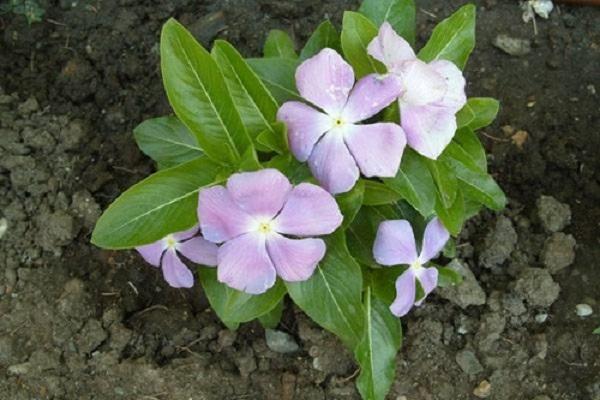
Seed preparation
The seeds are soaked in water with a growth stimulator for 23 hours. Then it is etched in potassium permanganate for 30 minutes. Then they are dried and sown directly on a flower bed or in boxes with a substrate for seedlings.
Soil requirements
Catharanthus can grow on loam and sandy loam non-acidic soil. 3 weeks before planting, it is recommended to dig up the soil, dilute it with sand and peat, and fertilize with rotted humus. For catharanthus, garden, leaf or sod land is suitable. At the bottom of the flower bed, it is advisable to pour some stones or expanded clay for drainage. In too swampy soil, catharanthus can rot. The soil should not be acidic; to normalize acidity, you can add some ash to the soil.
Landing scheme
The seeds are poured into shallow grooves at a distance of 3 centimeters from each other, and sprinkled with earth 1 centimeter thick. Then the plantings are watered, covered with a film, after a week the seeds germinate. The grown seedlings are thinned out, leaving larger shoots. If pre-grown seedlings are transplanted into a flower bed, then for each plant a separate hole is prepared to the depth of a glass or pot in which there is a small bush. The plant, together with a lump of earth, is planted in a hole. Be sure to keep your distance. There should be a distance of at least 25 centimeters to the neighboring flower.
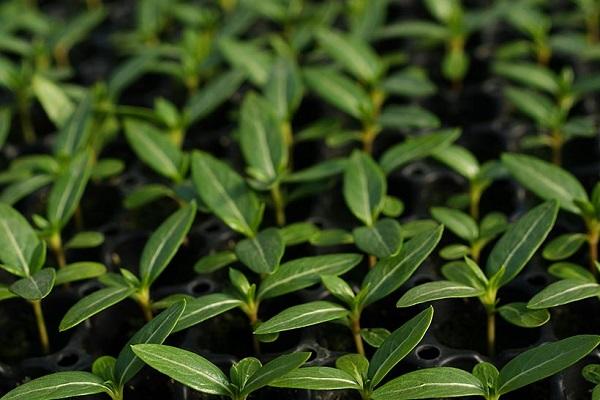
Care
Katarantus is an unpretentious culture. However, this plant will bloom profusely and continuously if properly cared for.
Watering the young
The growing plant needs to be watered regularly, and in the heat - water the leaves. If the catharanthus lacks moisture, it signals this very eloquently - its leaves curl up into a tube. The bushes are watered daily with soft, settled, preferably rainwater.
Loosening and weeding
After irrigation, the land must be loosened, the formed hard soil crust must be removed. Such a procedure will saturate the earth with oxygen. Weeds that have appeared must be removed from the flower bed so that they do not take away nutrients.
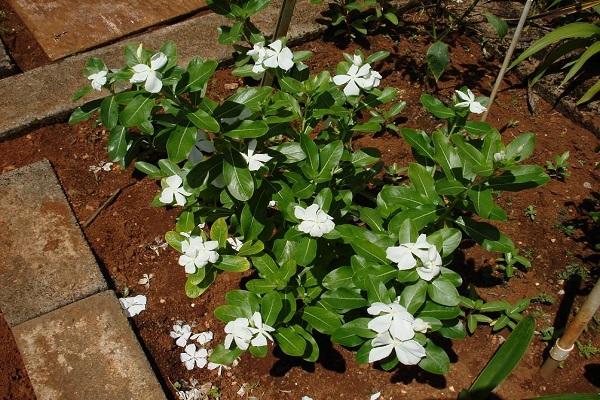
Mulching
The land near the catharanthus can be mulched, for example, with sawdust, small stones, sand. Mulch will keep the soil from evaporation and prevent weeds from breaking through.
Top dressing
You need to feed the catharanthus from spring. For the first time, top dressing is applied 3 weeks after germination. During the growth period, nitrogen fertilizer is added to the soil. Before flowering, the bushes are fed with phosphorus and potassium preparations. You can use complex fertilizers for flowering plants. Catharanthus are fed once every 3 weeks.
The foliage can be sprayed with Epin-Extra fertilizer solution. You can use wood ash as a top dressing. Fertilizing the soil, you must strictly observe the proportions and not exceed the permissible norms. No more than 30 grams of top dressing is taken per square meter of the site.

Diseases and pests
In cool weather or during lingering rains, this thermophilic plant can get sick. Most often, catharanthus are affected by a fungal infection, yellow, brown, light spots appear on the leaves. To prevent possible diseases, plants are sprayed with fungicides in the spring (Fitosporin).
In the heat, the catharanthus are attacked by insects (spider mites, scale insects). Spraying with insecticides (Actellik, Fosbecid) will save from pests.
Pruning
The tops of the bushes 15 centimeters high need to be pinched to form more lateral processes. Strongly protruding shoots are shortened to give the bush a compact spherical appearance. Be sure to cut off weak and yellowed shoots. Varietal (hybrid) catharanthus independently form a low bush. In such plants, only yellow leaves and stems are cut off.

Winter care at home
Some gardeners grow catharanthus in the garden in the summer, and take them into the room for the winter. The bush is carefully, together with a lump of earth, transplanted into a deep and narrow pot, watered and looked after all winter like an ordinary indoor flower. The stem with leaves can be cut off before wintering. In this case, the root remaining in the ground is not watered, but kept in a cool place until spring. You can immediately sow seeds in a container with a substrate and grow the catharanthus as a houseplant, and in the summer take it outside.
Humidity
Catharanthus grows in high humidity conditions. In a hot room with dry air, the plant develops slowly, and its leaves curl and dry out.
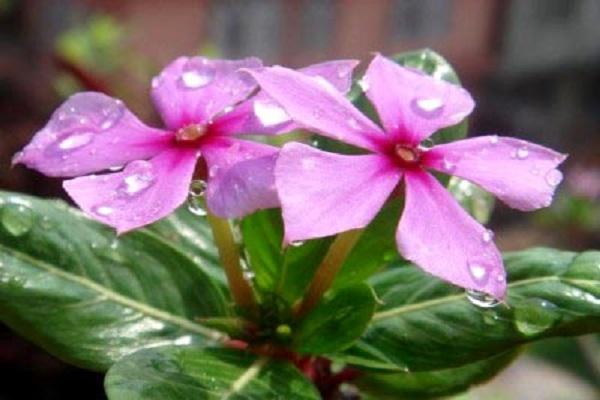
Spraying
Every day, the leaves of the catharanthus should be sprayed with water. In the heat, the bushes are irrigated several times a day.
Watering
Water the catharanthus with soft and settled water. Watering is carried out daily. The liquid collected in the pan must be poured out. In winter, plants are watered less often than in summer, but make sure that the soil does not dry out.
Lighting
Katarantus prefers diffused lighting. The flower pot can be placed on the windowsill. From the midday rays of the sun, the plant needs to be shaded.
Temperature
In spring and summer, catharanthus are provided with a temperature of 20-25 degrees Celsius. In autumn and winter, the air temperature can be slightly lower, and equal to 18 degrees above zero.

Top dressing
In winter, the catharanthus is not fed. Fertilize this flower only in spring and summer. Usually, fertilizing is applied twice: in the spring - during the growth period and in the summer - before flowering. The bushes are first fertilized with nitrogen substances, and then with potassium and phosphorus.
Pot
For catharanthus, a deep and not too wide pot with a drainage hole at the bottom is suitable. A little small pebbles are poured at the bottom for drainage, and then the container is filled with a substrate.
Pruning and shaping the bush
The branches of the catharanthus are cut in the spring. The upper shoots are shortened by a third. This method helps to rejuvenate the plant and form a spherical, low bush. Cut cuttings can be placed in a jar of water for subsequent rooting.

Transfer
Catharanthus grow quickly, so they are transplanted into a larger pot every year. If the roots are cramped and there is not enough space for development, the culture will stop blooming, and the leaves may turn yellow. The transplant is carried out in the spring, using the transshipment method, so as not to damage the roots. In a new pot, the plant quickly revives and begins to grow actively. Some gardeners transplant catharanthus from a pot to a flower bed in the spring. In this case, you must first prepare the soil and dig a hole.
Reproduction
Catharanthus reproduce by seeds, cuttings, or by dividing the bush. The right time for breeding is spring. Seeds of varietal and hybrid catharanthus are best purchased in a specialized store.
Growing from seeds
In March, seeds are sown for seedlings, and at the end of May, the grown plants are transferred to the street. For planting catharanthus, they take small containers (boxes) and soil for geraniums. You can independently prepare a substrate from sod (leaf) soil, humus, sand and peat. Seeds are soaked in water before sowing, then disinfected with potassium permanganate. Spread evenly over the surface and sprinkle with earth. Seed containers are watered and covered with glass.
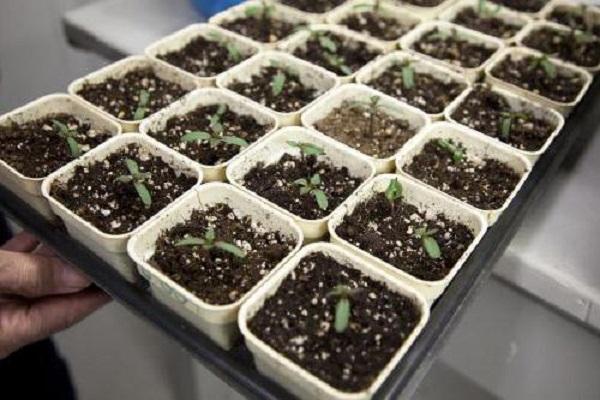
After a week, seedlings appear, the optimum temperature for keeping seedlings is 20-25 degrees Celsius.Seedlings are regularly watered, and after 3 weeks, when 3-4 true leaves appear, they dive into separate plastic or peat cups. Before transplanting, containers with seedlings are taken outside for several hours so that they get used to the outside temperature. Catharanthus are transplanted to a flower bed at the end of May, when the threat of night frosts has passed.
Cuttings
Catharanthus can be propagated using green cuttings. To do this, in the spring, you need to cut off the apical stalks 10 centimeters long and root them in a well-moistened sandy-peat soil. During rooting, the cuttings are covered with a clear plastic bottle. They need to be ventilated and watered daily. After rooting, the cap is removed and the plant is looked after as usual. The grown bush can be transplanted into a flower bed after 3-4 weeks.
Dividing the bush
During transplantation, the catharanthus bush can be divided into two parts, and each division, along with the stem and root, can be planted in separate holes or in different pots. It is better to divide the bush in early spring.

Popular species and varieties
The genus of catharanthus consists of 8 species and several decorative varieties. Mainly cultivated pink catharanthus. It is a small branched bush with greenish, oblong leaves and five-petalled flowers of snow-white or all kinds of shades of pink.
Burgundy
A low, lush blooming bush (up to 40 centimeters). Flowers - medium size, with 5 petals, crimson, with a light center.
Pacific White
Compact lush bush up to 25-35 centimeters high. Against the background of dense foliage, there are white five-petal flowers with a red eye in the center.
Epricot
This catharanthus has cream flowers with a raspberry center. The bush grows up to 35 centimeters in height.
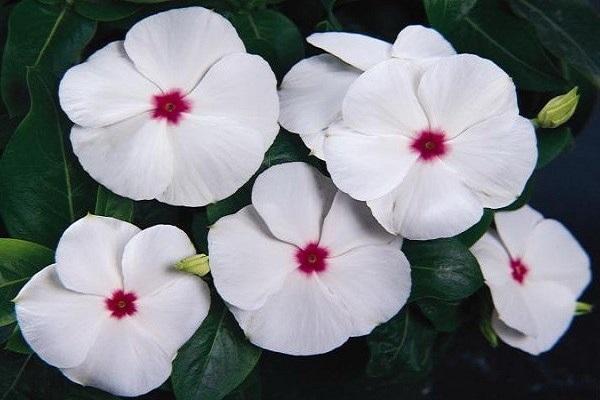
Ice pink
The catharanthus has small pale pink flowers with a red eye. The bush is compact, up to 35 centimeters in height.
Grape Cooler
A low bush with oblong shiny greenish leaves. Flowers - light pink with a crimson center.
Peppermint Cooler
Snow-white flowers with a bright red center. The branching bush reaches 40 centimeters in height.
Red Cooler
Catharanthus with bright scarlet flowers. The diameter of one flower is up to 5 centimeters.
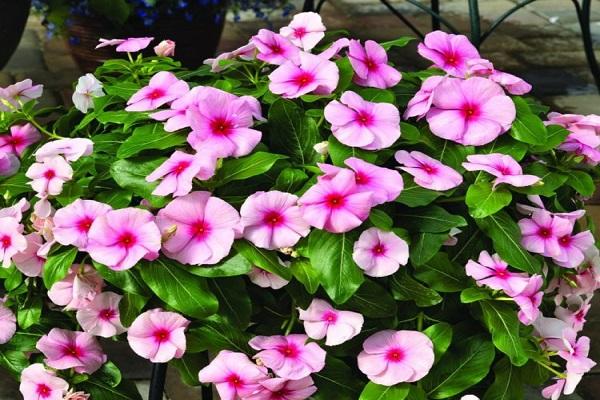
First Kiss Bluebury
Bush 35-45 centimeters high. Flowers - lilac with a dark center.
Cascade
Ampel catharanthus with flowing shoots. This lush bush has stems up to 75 centimeters in length. Leaves are small, oblong, rounded at the end. The whole bush is strewn with delicate, five-petalled crimson or lilac flowers with a white center.
Titanium
Ampel culture with stems up to 75 centimeters long. Flowers - five-petal, red.
Deep Rose
Pink catharanthus with 5-petal, medium-sized flowers. The bush is compact, up to 40 centimeters long.
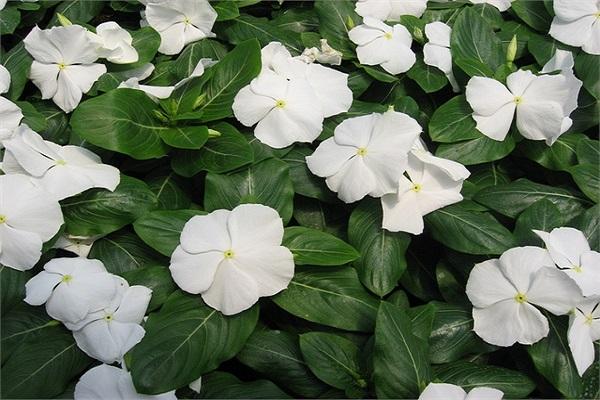
Grape
This culture has lilac flowers with a pink eye. The plant itself is low (up to 40 centimeters in height).
Ed
A plant with a lush bush, abundantly strewn with red flowers. The height of the culture is 30-40 centimeters.
First kiss
Abundantly leafy, branching bush 30-40 centimeters high. It has oblong, shiny, dark green leaves and delicate flowers up to 6 centimeters in diameter. The petals are light at the edges, the middle of the flower is darker. Flowers can have a lilac, coral hue.

Reproduction
Catharanthus can be propagated by seeds, cuttings or by dividing the bush. The ideal time for breeding is early spring.
Cuttings
For reproduction, take the upper stems obtained during spring pruning. The length of the cutting should be 10-12 centimeters, the lower leaves are cut off. The twigs are placed in a jar of water or in a damp substrate and rooted for 3-4 weeks.
Seeds
It is better to buy seeds for sowing in a specialized store.Indeed, on a flower bed, catharanthus do not have time to ripen over the summer. You can dig up these plants in the fall and grow them in the room. In this case, the seeds will ripen by spring. They are soaked for a day and planted in boxes with a substrate in March, and at the end of May, the grown seedlings are transplanted to a flower bed.
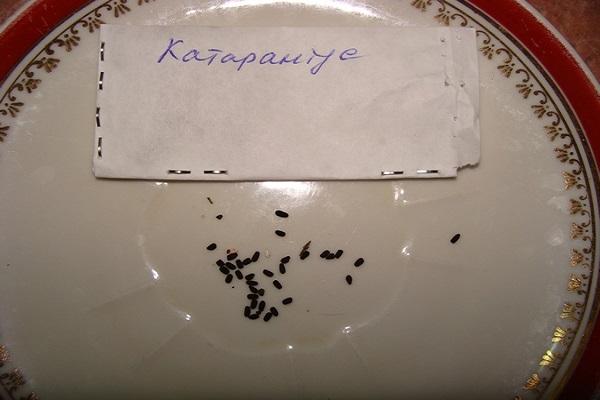
Dividing the bush
In the spring, when a bush is transplanted from a pot to a flower bed, you can divide it in half. The catharanthus is divided into 2 parts, the stem is cut with a knife at the very base, and then each part of the bush, together with a piece of the root, is planted in separate containers or pits.
Features of growing at home
Catharanthus love water. You must always remember this and not leave the flower for a long time without watering. In the heat, the bush can be sprayed with water. It is advisable to transplant it into a larger pot once a year. In spring and summer, the catharanthus is given complex feeding for flowering plants. In early spring, the stems are slightly shortened. For the summer, flower pots can be taken out on the veranda or outside.
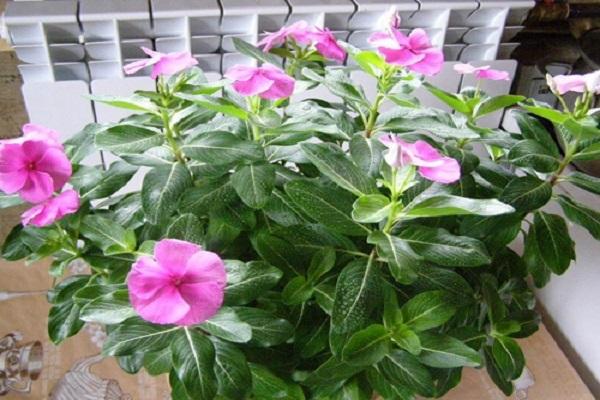
Medical use
Catharanthus contains 65 different alkaloids. Most of them are in the roots. Alkaloids have antitumor activity. Leaves and stems are used to treat malignant neoplasms. They make tinctures, decoctions, extracts from them. Raw materials are harvested closer to September, during the period of seed ripening. Leaves and shoots are dried in a dark and hot place. Dried herbs are used for the first year, then they lose their medicinal properties.
With the help of catharanthus, leukemia, cancer of the breast, uterus, sarcomas, varicose veins, stomach ulcers, prostatitis are treated. The plant normalizes blood sugar levels, lowers blood pressure, cures psoriasis, and is used as a pain reliever. For treatment, well dried raw materials are used, since fresh leaves and stems are very poisonous.









